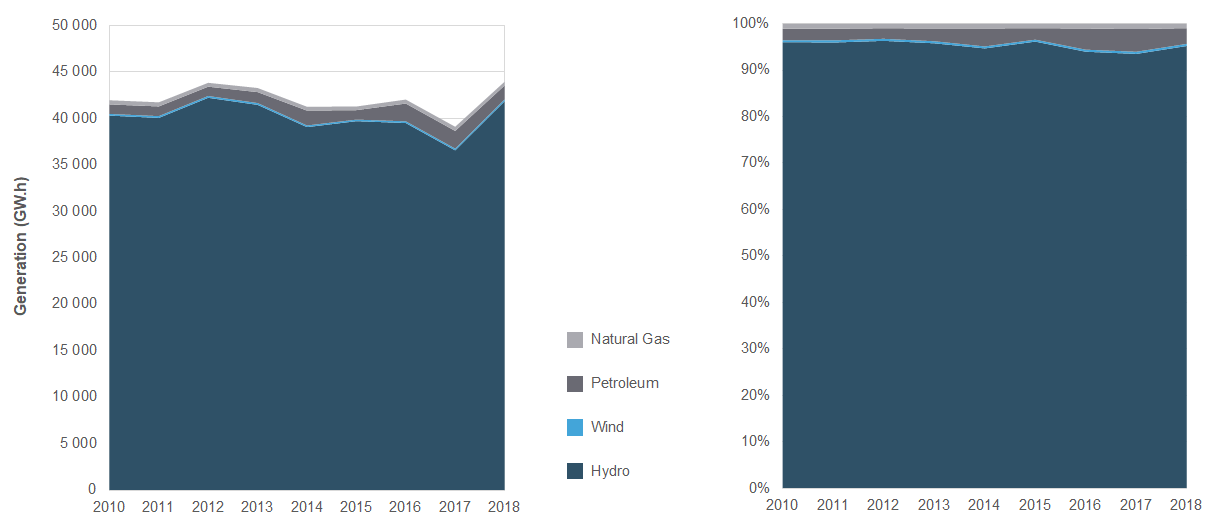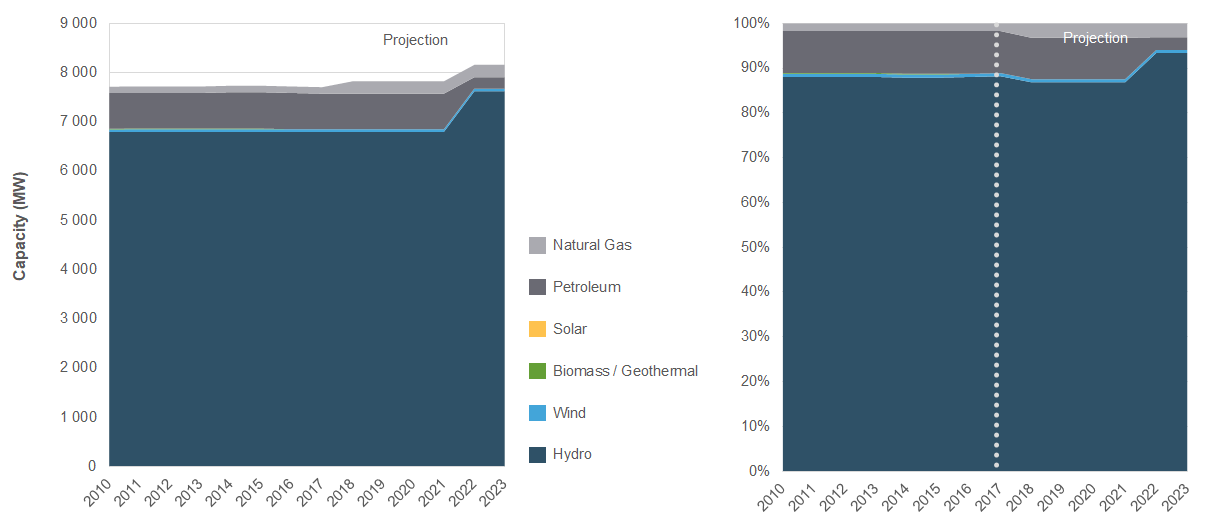Canada's Renewable Power – Newfoundland and Labrador

Newfoundland and Labrador
Newfoundland and Labrador is a significant generator and exporter of hydroelectricity in Canada. With the completion of the Labrador-Island Link in early 2020, the island of Newfoundland joined the interconnected North American electricity grid.
Generation Trends
Newfoundland and Labrador is the third largest producer of hydroelectricity in Canada (after Quebec and British Columbia). The Churchill Falls Generating Station in Labrador is the second largest hydro facility in Canada, with an installed capacity of 5 428 megawatts (MW), and annual generation of about 34 000 gigawatt-hours (GW.h). Under an agreement with Hydro-Québec, a significant portion of generation at the facility is exported to Quebec. In 2018, Newfoundland and Labrador generated 41 831 GW.h from hydro and a relatively small amount (206 GW.h) from wind. Total renewable generation in 2018 was 42 036 GW.h, or 95.7% of total generation.
Thermal generation for residents in the province is from oil and diesel. The heavy oil-fueled Holyrood Thermal Generating Station on the island of Newfoundland is scheduled for decommissioning in March 2022, after the startup of Muskrat Falls. Diesel-fired generation is used by 14 remote communities, primarily along the coast of Labrador and the southern coast of Newfoundland. Natural gas is used for electricity generation on offshore oil drilling rigs. Total thermal generation in 2018 was 1 897 gigawatt-hours (GW.h), or 4.3% of total generation.
Total electricity generation in Newfoundland and Labrador grew from 41 942 GW.h in 2010 to 43 933 GW.h in 2018. Changes in Newfoundland and Labrador’s electricity generation mix are illustrated in Figure 1.
Figure 1. Electricity Generation in Newfoundland and Labrador

Source and Description
Source: CER – Canada’s Energy Future 2020 (EF2020)
Description: This graph illustrates electricity generation from 2010 to 2018 in Newfoundland and Labrador. In 2010, Newfoundland and Labrador’s total generation was 41 942 GW.h (96.5% renewable). In 2018, total generation was 43 933 GW.h (95.7% renewable).
GHG Emissions from Electricity Generation
In 2018, Newfoundland and Labrador’s electricity sector emitted 1.1 megatonnes of carbon dioxide equivalent (MT of CO2e). Newfoundland and Labrador’s generation intensity was 26 grams of CO2e per kilowatt-hour.
Newfoundland and Labrador produced 1.6% of Canada’s total greenhouse gas emissions from electricity generation in 2018.
Recent and Projected Capacity Changes for Renewables
Between 2010 and 2017, Newfoundland and Labrador added a net 3 MW of renewable capacity (hydro). Between 2017 and 2023, Newfoundland and Labrador is expected to add 824 MW of new net renewable capacity, entirely from the Muskrat Falls hydro project. These capacity changes are illustrated in Figure 2 with data provided in Table 1.
Muskrat Falls was initially expected online in December 2017, but the project has been delayed by over two years with the latest setback occurring in March 2020 from COVID-19 disruptions. Nalcor’s latest start date estimate is September 2021. The power from Muskrat Falls would be delivered to Nova Scotia via the Maritime Link sub-sea cable.
The 490 MW Holyrood Thermal Generating Station provides between 15-25% of the island of Newfoundland’s electricity annually. Holyrood burns 0.7% sulphur heavy oil. As noted above, the facility is scheduled for decommissioning in March 2022.
Figure 2. Electricity Capacity and Future Changes in Newfoundland and Labrador

Source and Description
Source: CER – EF2020
Description: This graph illustrates historical electricity capacity from 2010 to 2017 in Newfoundland and Labrador and the CER’s projection of future capacity changes from 2018 to 2023. In 2010, Newfoundland and Labrador’s total installed electricity capacity was 7 698 MW (88.9% renewable). In 2017, capacity had grown to 7 702 MW (88.9% renewable). By 2023, total capacity is projected to grow to 8 156 MW (94.1% renewable).
Table 1. Electricity Capacity (2010 – 2023) and Generation (2010 and 2018) in Newfoundland and Labrador
| Capacity in MW and % | Generation in GW.h and % | ||||||
|---|---|---|---|---|---|---|---|
| 2010 | 2017 | 2018 | 2020 | 2023 | 2010 | 2018 | |
| ---------- Projected ---------- | |||||||
| Hydroelectricity | 6 791 | 6 794 | 6 794 | 6 794 | 7 618 | 40 287 | 41 831 |
| 88.2% | 88.2% | 86.8% | 86.8% | 93.4% | 96.1% | 95.2% | |
| Wind | 54 | 54 | 54 | 54 | 54 | 183 | 206 |
| 0.7% | 0.7% | 0.7% | 0.7% | 0.7% | 0.4% | 0.5% | |
| All Renewable Sources | 6 845 | 6 848 | 6 848 | 6 848 | 7 672 | 40 470 | 42 036 |
| 88.9% | 88.9% | 87.5% | 87.5% | 94.1% | 96.5% | 95.7% | |
| Natural Gas | 132 | 132 | 252 | 252 | 252 | 455 | 411 |
| 1.7% | 1.7% | 3.2% | 3.2% | 3.1% | 1.1% | 0.9% | |
| Oil and Diesel | 722 | 723 | 723 | 723 | 233 | 1 017 | 1 486 |
| 9.4% | 9.4% | 9.2% | 9.2% | 2.9% | 2.4% | 3.4% | |
| All Thermal Sources | 854 | 854 | 974 | 974 | 484 | 1 472 | 1 897 |
| 11.1% | 11.1% | 12.5% | 12.5% | 5.9% | 3.5% | 4.3% | |
| All Sources | 7 698 | 7 702 | 7 822 | 7 822 | 8 156 | 41 942 | 43 933 |
- Date modified:
